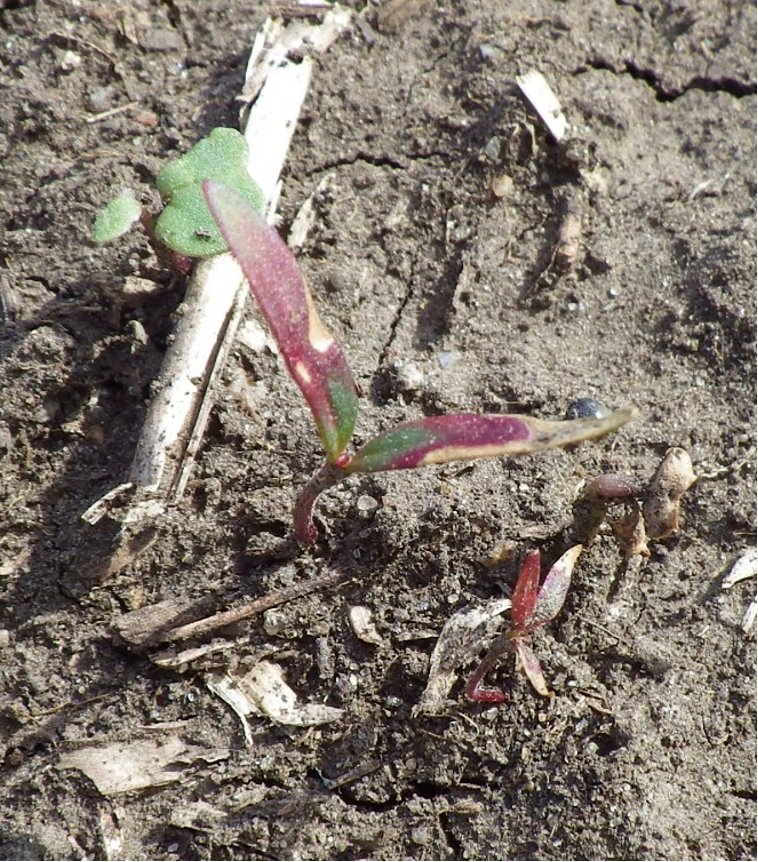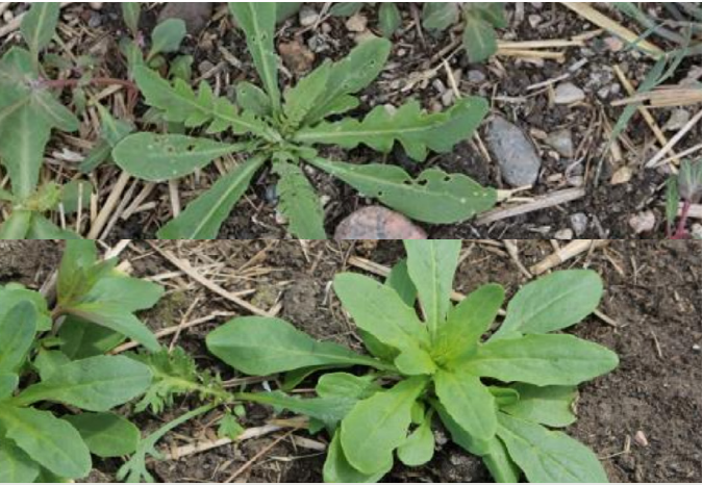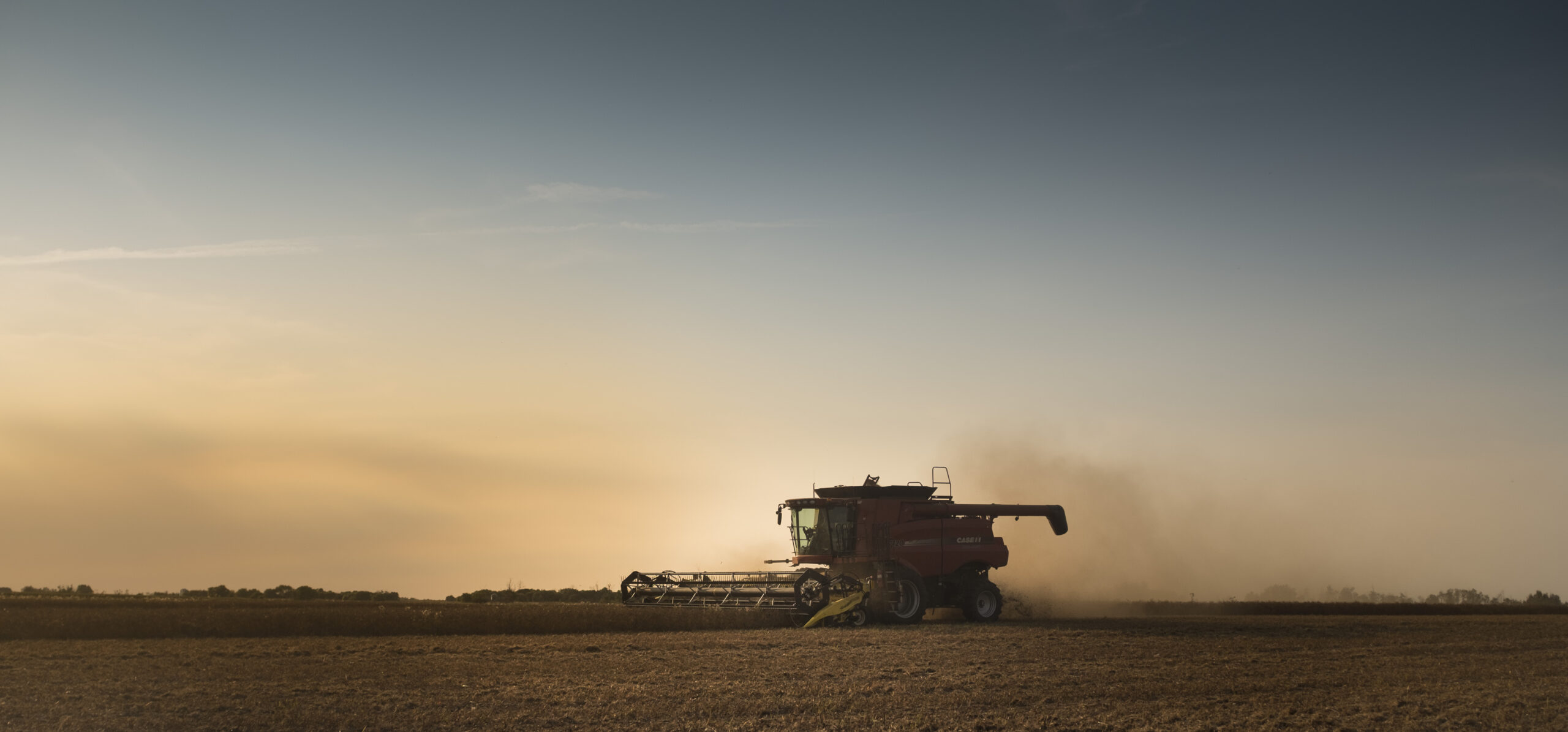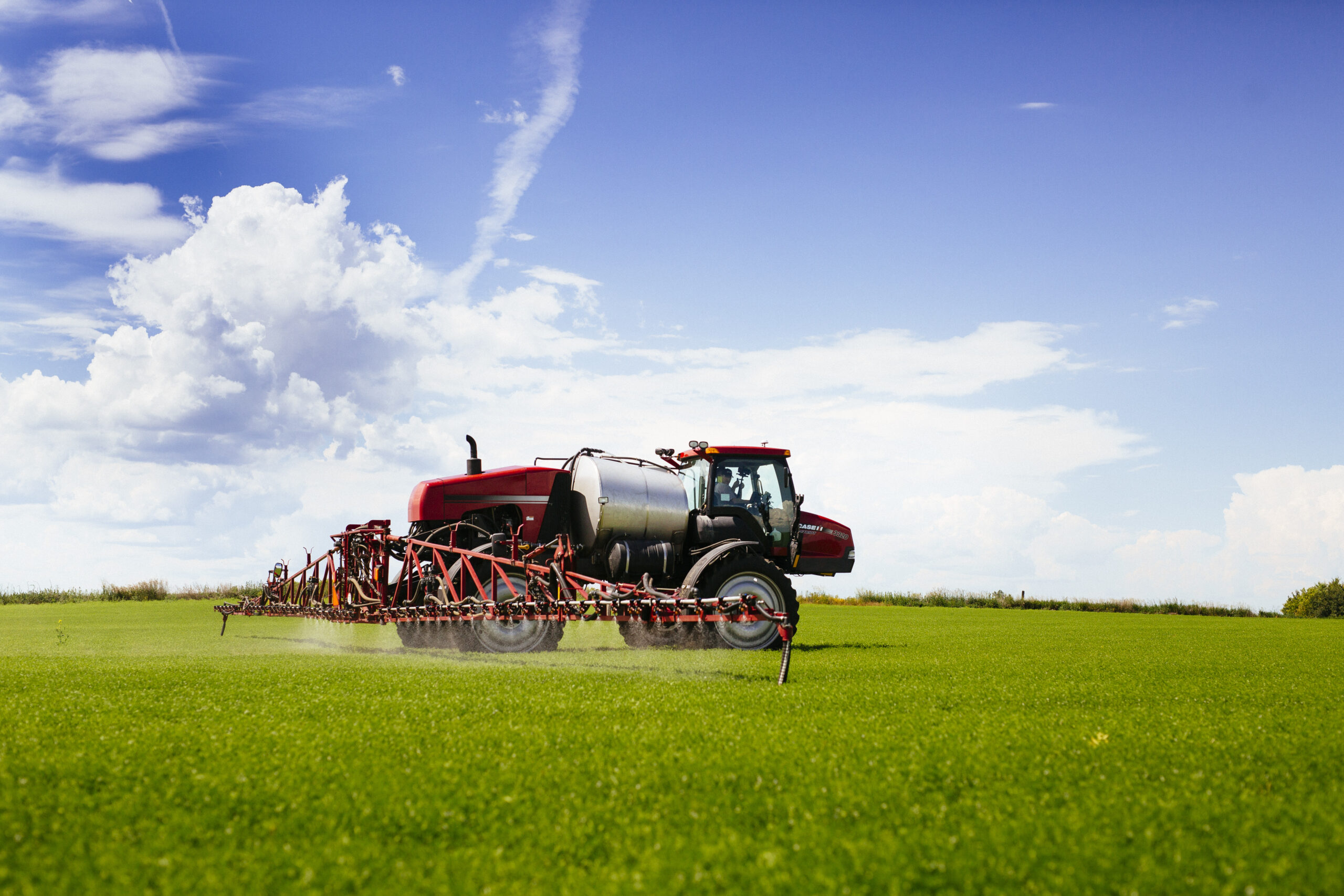By Jennifer Bogdan, PAg, CCA
Soil residual herbicides are products that have longer persistence in the soil, allowing them to control weeds for an extended period of time during the growing season. This extended activity is very
beneficial for pulse crops due to their general lack of competitiveness against weeds. Pulse crops experience different critical weed-free periods, where weed competition during key growth stages has a negative impact on yield. Early weed control provided by soil residual herbicides is very beneficial for pulse crops during these critical growth stages. More information can be found in the fact sheet Critical Period of Weed Control in Pulses.
Soil residual herbicides are also important tools in managing herbicide resistance in weeds because they utilize the less used Group 3, 14, and 15 modes of action. Weeds resistant to other herbicide groups have become a difficult problem to manage in pulse crops. For example, Group 2, 4, and/or 9-resistant kochia, Group 2-resistant cleavers and wild mustard, and Group 1 and/or 2-resistant wild oat populations are increasing in pulse crops due to the lack of in-crop control options for these weeds. Rotating, tank-mixing, and/or layering with different modes of action is necessary for managing herbicide-resistant weeds, and these resistance management strategies can be incorporated into pulse crop production by using soil residual herbicides. Group 3 and 15 herbicides are available only as soil residual products. Group 14 herbicides are available in both soil residual and foliar products, depending on the specific active ingredient.
Herbicides offering soil residual weed control can be used as a single application in rotation or as part of a tank-mix in the fall or spring. They are also an important part of the herbicide layering resistance management strategy, where herbicides with different modes of action are used at different times of the growing season in pre- emergent and post-emergent applications. Layering allows multiple modes of action to be applied to specific weeds in order to reduce the amount of selection pressure caused by a single mode of action on a single weed species. These alternative resistance management strategies are becoming increasingly important for pulse crops.
How Soil Residual Herbicides Work
Group 3 Herbicides
Group 3 (dinitroanaline) herbicides include the active ingredients ethalfluralin and trifluralin. Group 3 herbicides enter cells undergoing cell division and prevent the formation of microtubules, the structures responsible for pulling the chromosomes apart during cell division. Because they have essentially duplicated themselves but cannot divide or elongate, the cells become enlarged.
Group 3 herbicides affect the cells in the meristems, which are the most actively growing regions in seedlings, with the roots being particularly sensitive. Root meristems are impacted at the root tips and lateral buds on the sides of the root. Damaged root tips appear swollen and stubby because the duplicated cells cannot divide, and no secondary roots or root hairs will grow. Shoot meristems are located at the base of the cotyledons in broadleaves and at the crown, just above the coleoptilar node, in grasses. Group 3 injury results in thickened hypocotyls (the stem below the cotyledons) in broadleaves and shortened coleoptiles (the stem above the crown) in grasses. The majority of susceptible weeds do not emerge from the soil.
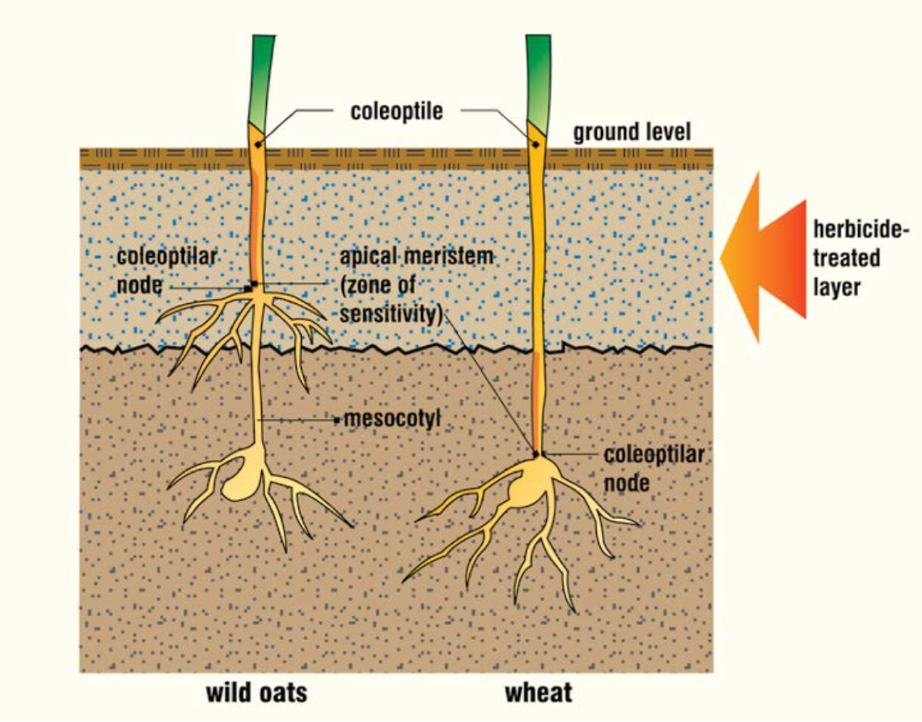
Source: Hall, L., Beckie, H., and Wolf, T.M. (1999). How Herbicides Work.
These active ingredients act on a plant by means of herbicide placement as a treated layer in the soil. The weed must germinate within the treated layer in order to intercept the herbicide. Weeds germinating below the treated layer may be unaffected unless their roots grow into the treated zone. An exception to this can be with wild oats and green foxtail. These species exhibit mesocotyl elongation, where the sensitive coleoptilar node gets pushed up into the herbicide-treated layer, even if the seed germinates below this layer, and the herbicide moves into the coleoptilar node, affecting cell division (Figure 1).
The depth of the herbicide-treated layer relative to the depth of the weed seedbank is important for Group 3 herbicide efficacy. In conventional systems, the weed seedbank is deeper in the soil profile, so the herbicide must be incorporated at a reccomended depth of 1/2″. In direct seeding systems, the weed seedbank is concentrated at or near the soil surface, so a surface application of granular herbicide to standing stubble followed by incorporation with a shallow harrowing can be used.
The selectivity of Group 3 herbicides between sensitive and insensitive broadleaved plants is thought to be related to the oil content of the seed. These highly lipophilic herbicides move as a vapour into the seed coat but do not actually enter the plant because they become trapped in the lipid cell membranes. The higher oil content in the seed coats of certain plant species, such as pulse and oilseed crops, prevents the activity of Group 3 herbicides from affecting these plants, providing excellent crop tolerance. This is also the reason why certain weeds, such as wild mustard, are not controlled by these herbicides.
Group 14 Herbicides
Group 14 (protoporphyrinogen IX oxidase, PPO, inhibitors) soil residual herbicides include flumioxazin and sulfentrazone. These herbicides interfere with the production of chlorophyll. A secondary compound builds up that reacts with oxygen to create singlet oxygen, a highly charged particle that moves around the cell. The negatively- charged singlet oxygen becomes attracted to the positively-charged hydrophobic interior of the cell membrane. The singlet oxygen disrupts the integrity of the membrane, causing the cell contents to leak out. Plant tissues develop a water-soaked appearance, followed by bleaching and tissue death (necrosis).
Group 14 pre-emergent herbicides are applied directly to the soil, forming a herbicide-treated layer that weeds grow through, absorbing the herbicide as they pass through (Figure 2). Once they emerge and are exposed to sunlight, susceptible weeds die as they try to produce chlorophyll.
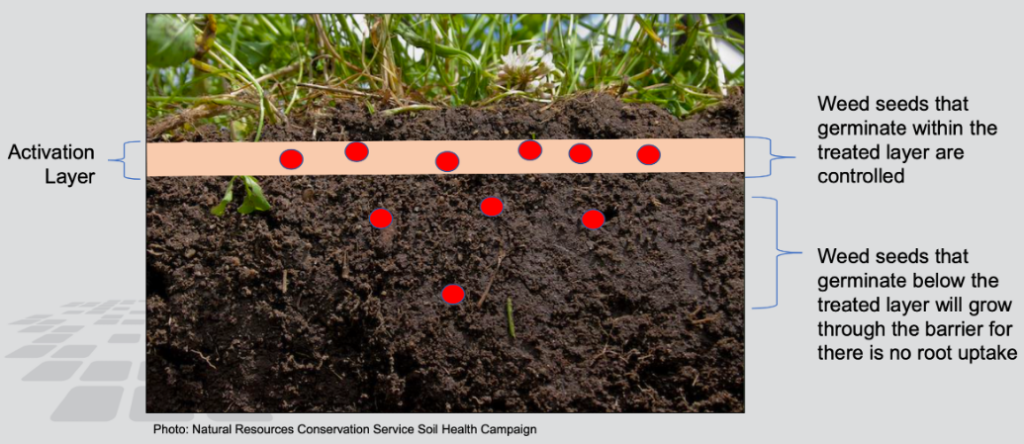
Source: FMC
Flumioxazin is absorbed primarily through the shoots, with some root uptake. Sulfentrazone is primarily taken up by the roots of seedlings germinating in the herbicide-treated layer, with some shoot uptake. The herbicide active layer is formed in the top 1 to 2 inches of soil, depending on soil parameters (organic matter, pH, texture, moisture).
What to Expect: Soil residual herbicides work by creating an active herbicide layer in which the weed seeds germinate in, taking up herbicide as they grow. Susceptible weeds typically die before or as they emerge, depending on the soil applied active used. Established weeds (perennials, winter annuals) or weeds that have already emerged before soil residual herbicide application will not be controlled. In these situations, a fall or spring burn-off is required.
Group 15 Herbicides
Group 15 herbicides (very long chain fatty acid, VLCFA, inhibitors) include pyroxasulfone and triallate. In 2021, Group 8 herbicides, which included triallate, were all reclassified as Group 15. These herbicides inhibit the production of very long chain fatty acids, which are needed for the production of membranes for cell development, as well as cuticles and waxes for preventing water loss from the outer surfaces of plant tissues. Without these VLCFAs, membranes lose their structure and cell division is disrupted. Affected weeds often do not emerge from the soil. If wild oat shoots do emerge, they will appear swollen from the inhibition of cell elongation and will be pinched off beneath the soil surface.
Triallate affects grassy weeds (primarily wild oats) and enters the plant through the coleoptile and coleoptilar node (i.e. the main shoot) while growing through the herbicide-treated layer. Because of this shoot uptake, triallate is more efficacious on deeper wild oats than herbicides that act only on the roots. Due to its lipophilic nature, triallate stays in lipid membranes of seeds and seedlings, and performs best in rapid growing conditions. Triallate is a very safe option for pulse crops because it does not have activity on broadleaved plants.
Pyroxasulfone is taken up primarily through roots, but also through the developing below-ground shoots of germinating weeds. On shallow germinating weeds in the treated soil, uptake will occur through both the roots and the shoots, providing the best efficacy. Because the root needs to be in the treated soil for uptake, pyroxasulfone may not work as well on deeper germinating weeds.
Environmental Factors Influencing Soil Residual Herbicides
Soil Moisture and Rainfall
Group 3 herbicides and triallate do not rely on rainfall for activation. Moist soil present in minimum-till systems and from snowmelt in the spring is usually enough for these herbicides to be effective.
In very dry soils, ethalfluralin, trifluralin, and triallate are more tightly bound to the soil particles, making the herbicide unavailable for weed activity until rainfall is received. Dry soil conditions between application and emergence may result in reduced weed control. While these herbicides may be less active in dry soil conditions, weed germination will also be less.
Triallate has low water solubility and low mobility in the soil. Ethalfluralin and trifluralin also have very low water solubility and are relatively immobile in the soil. Leaching is not a concern with these active ingredients, so any negative impacts of excessive rain is related to physical soil movement. Heavy rainfall can cause soil, and therefore herbicide, erosion from water run-off, leading to less weed control. Heavy rainfall that causes water to pond on the soil surface for three to five days or longer can also result in rapid anaerobic breakdown of Group 3 herbicides, reducing weed control. If spring flooding is expected on susceptible land, apply the herbicide after the soil has dried out. Soil that is too wet will not mix properly, resulting in stripping and patchy weed control due to the uneven distribution of soil-incorporated herbicides.
Moisture plays a critical role in the activity of Group 14 and pyroxasulfone pre-emergent residual chemistries. After these products are sprayed on the soil, rainfall is required to wash the herbicide off of the stubble or soil surface and into the soil where it dissolves in the soil water. This “activation” of the herbicide allows it to be taken up by weeds germinating in the active layer. Once within the soil, an equilibrium is established between the amount of herbicide bound to clay particles and/or organic matter and the amount dissolved in soil water. The amount of active ingredient readily available for weed uptake depends on the characteristics of the herbicide, the soil texture, soil pH, and available moisture. As the soil dries up, the herbicide is adsorbed back onto the clay and organic matter, and is unavailable for plant uptake until more rainfall is received. As subsequent rainfall fills the soil pore spaces with water, the herbicide releases from the clay and/or organic matter and becomes part of the soil solution again.
Flumioxazin and sulfentrazone require 10 to 15 mm (1/4 to 1/2 inch) of rainfall at once in order to become activated. Pyroxasulfone requires a minimum of 15 mm (1/2 inch) of rainfall at once, and ideally 20 mm (3/4 inch) in heavier crop residue, to become activated.
Group 14 pre-emergence herbicides and pyroxasulfone will remain on the soil for a number of weeks after application until activated by rainfall (the length of time varies by active ingredient and soil parameters). These herbicides are broken down primarily by microbial degradation.
When the soil parameters fall outside of what is permitted on the label, heavy rainfall can potentially cause Group 14 herbicides and pyroxasulfone to move deeper into the soil profile and, depending on seeding depth, be taken up by germinating crop seeds and cause temporary injury. Crop injury can also occur after extreme rainfall causing extended periods of saturated soil where the crop seeds were seeded shallow and are germinating in the herbicide-treated layer. In these situations, it is the soil parameters such as organic matter and texture (ability of the soil to bind these herbicides to prevent movement), as well as pH (makes herbicides more or less available or soluble) that will determine how much herbicide the crop will take up. The crop injury is temporary and will not typically lead to yield loss. With flumioxazin, heavy rain that causes water pooling can also allow a concentrated band of herbicide to form and emerging lentils (from ground crack to first node) can be damaged by the main shoot pinching off. Water pooling can occur in areas of higher soil compaction, clay content, and/or seeding packing pressure. Selectivity with Group 14 herbicides and pyroxasulfone is based on crop metabolism; therefore, conditions that are unfavourable to crop growth (cool weather, extreme moisture, poor agronomic practices) can negatively affect the plant’s ability to break down the herbicide.
What to Expect: Rainfall is required in order to activate Group 14 residual herbicides and pyroxasulfone. Susceptible weeds will not be controlled until herbicide activation from rainfall. These weeds include kochia and Russian thistle which can germinate in very low moisture levels in the soil. Each active ingredient must receive a minimum amount of precipitation in a single rain event. Group 3 herbicides and triallate do not have the same rainfall requirement; spring soil moisture from snowmelt is usually sufficient to activate these herbicides.
Soil Organic Matter
Soil organic matter has a large influence on all soil residual herbicides. Organic matter particles are binding sites for herbicides, making them unavailable for plant uptake (“tie-up”). Organic matter is also rich in soil microbes, which are primarily responsible for the breakdown of these herbicides. As soil organic matter increases, the herbicide application rate must also increase to compensate for herbicide unavailability. At very high levels of organic matter, too much of the herbicide becomes unavailable and weed control is not effective. For Group 14 and pyroxasulfone, at very low levels of organic matter (less than 1.5 to 2%, such as on eroded knolls), there is less tie-up so more herbicide is free to wash into the rooting zone of the crop after a heavy rain, increasing the risk of crop injury. Group 3 herbicides and triallate do not pose any risk of injury to pulses from herbicide wash-down into the rooting zone. Herbicide carryover into the next season with some active ingredients can also be a concern in low organic matter areas due to less microbial breakdown under extreme drought conditions. Consult the manufacturer for specific recropping recommendations after a drought year.
Soil organic matter is the number one factor affecting Group 3 and triallate herbicides. These herbicides should not be used on soils with organic matter above 15% or less than 2%. Low-lying areas have higher organic matter levels and higher weed populations, so in-crop spraying of weed breakthroughs may still be required in those areas of the field.
Herbicide tie-up can be a concern on soils with greater than 6% organic matter for sulfentrazone, 7% organic matter for pyroxasulfone, and 8% organic matter for flumioxazin (research is underway to update the organic matter parameters for flumioxazin).
Soil Texture
Clay particles are the smallest soil particle but have the largest surface area for herbicides to bind to. Clay particles also possess a negative charge, which attract any herbicides that have a positive charge. Therefore, heavy or fine-textured clay soils have a greater ability to adsorb herbicides compared to light or coarse-textured sandy soils. As clay content increases, more herbicide is bound to the soil particles and unavailable for weed control. As clay content decreases (i.e. sand content increases), the adsorption of herbicide to the soil colloids decreases and more herbicide will be free to move into the soil solution. Under heavy rainfall, this unbound herbicide can potentially leach in the soil profile and increase the risk of crop injury, depending on the characteristics of the active ingredient. Note that Group 3 herbicides and triallate do not pose a risk for injury to pulse crops.
For ethalfluralin and trifluralin, higher herbicide rates are required on medium to heavy-textured soils. Triallate is not greatly affected by soil texture.
Clay particles bind to sulfentrazone and pyroxasulfone, so higher rates should be considered on medium- to fine-textured soils. Sulfentrazone cannot be applied to soils classified as coarse-textured or to fine- textured soils with less than 1.5% organic matter. Pyroxasulfone cannot be applied to soils classified as sand containing less than 1% organic matter. Flumioxazin should not be used on extremely sandy soils, but can be applied to fine-textured soils (research is underway to update the soil texture parameters for flumioxazin).
Soil pH
Soil pH affects Group 14 herbicides and pyroxasulfone. As pH increases, water solubility increases and more herbicide is pulled away from the soil particles (organic matter and clay) and into the soil solution where it is available for uptake. As pH decreases, solubility decreases and binding to organic matter and clay increases, so herbicide availability is lowered. It is important to note that soil pH, organic matter, and soil texture all influence the availability of herbicides in soil.
Sulfentrazone and pyroxasulfone should not be used on soils with a pH of 7.8 or higher, as solubility is greatly increased. If a heavy rain event were to occur on soils with high pH coupled with low organic matter, such as on eroded knolls, there is an increased risk of these herbicides moving into the crop rooting zone and causing injury. For the same reason, flumioxazin may cause injury to lentils in areas of fields with combinations of low organic matter, high pH, and/or high sand content. Below pH of 5.5 to 6, flumioxazin starts to become less available and reduced efficacy may result.
Soil pH has no effect on ethalfluralin, trifluralin, or triallate, as they remain stable at all pH levels.
What to Expect: Soil organic matter, texture, and pH all interact together on the soil residual herbicides. Organic matter and clay particles bind the herbicide; too high of content results in herbicide tie-up and, for Group 14 herbicides and pyroxasulfone, too low of content increases the risk of herbicide movement in the soil and potential crop uptake under high rainfall. Soil pH additionally influences the solubility (availability) of Group 14 herbicides and pyroxasulfone. The interactions between organic matter, texture, and pH are driven by soil moisture. Herbicide rate structures have been developed to account for all of these soil processes in order to optimize efficacy and product performance.
Soil Temperature
Soil temperature influences soil microbial activity, which plays a large role in the breakdown of residual herbicides. Therefore, soil temperature needs to be considered when using soil residual herbicides, especially for applications in the fall.
For ethalfluralin and trifluralin, fall applications can begin after September 15 in conventional tillage systems and October 1 in minimum tillage systems. For triallate, begin fall applications once soil temperatures start to cool below 5°C; this usually occurs after October 1 on the Prairies. All fall applications must be made prior to soil freeze-up.
Triallate becomes active at 5°C in moist soil. In the spring, wild oats can germinate at lower temperatures (2-3°C), so some weed breakthrough can occur before the triallate is activated. Therefore, a pre-seed burn-off is recommended to control any emerged wild oats and other weeds that triallate will not control.
For flumioxazin and pyroxasulfone, herbicide application in the fall should occur when soil temperature is less than 10°C, until freeze- up. Waiting until the temperature is cooler will reduce the amount of microbial breakdown of the herbicides, therefore maximizing the extended weed control period the following season.
Management Factors Influencing Soil Residual Herbicides
Crop Residue
With granular products (ethalfluralin, trifluralin, triallate), heavy straw can impede the herbicide granules from contacting the soil surface. A light harrowing can be used to disturb the straw enough to allow the granules to fall through to the soil surface. Heavy crop residues can also interfere with proper herbicide incorporation in conventional systems so straw management must be considered during and after harvest.
Straw and chaff residue can tie up liquid formulations of trifluralin and triallate; for trifluralin, this also means the herbicide will be degraded by sunlight. Liquid formulations should only be used on fields that have low amounts of crop residue (70% exposed soil, or less than 30% crop residue) and are relatively free of lumps in order to reduce herbicide tie-up. The carbon in ash from burned stubble can also tie up trifluralin and triallate similarly to soils with high organic matter. Do not apply these products to burned fields for at least 12 months.
Flumioxazin, sulfentrazone, and pyroxasulfone will wash off of stubble. However, in situations of heavy or uneven crop residue, it will take more rainfall to push the herbicide down to the soil surface. Therefore, heavy harrowing may be required before application of these herbicides.
What to Expect: Residue management is important for granular herbicides that need to fall through the straw in order to reach the soil surface. Harrowing is often required after application to ensure good granule-to-soil contact. Liquid formulations of trifluralin and triallate are easily tied up in crop residue; soil must have less than 30% residue cover before these products are applied. For Group 14 herbicides and pyroxasulfone, any residue work such as heavy harrowing must be completed before herbicide application.
Tillage
Ethalfluralin and trifluralin are volatile compounds. As a result, incorporation into the soil is needed to avoid volatilization losses. Ethalfluralin and trifluralin can also break down in sunlight (photodegradation), and incorporation helps mitigate this loss by shielding the herbicide underneath the soil, hence the flexibility for an earlier fall application date under conventional tillage. In the spring, incorporation or harrowing should be completed within 24 hours of application to minimize volatilization and photodegradation losses as temperatures become warmer and days become longer at this time. In the fall, if soil moisture conditions are adequate, incorporation or harrowing can be performed within 24 hours or at any time before seeding. However, if soil moisture conditions are dry, it may be best to apply the granules in the fall and wait until spring for incorporation or harrowing to avoid soil erosion issues.
For granular ethalfluralin, trifluralin, and triallate in minimum or zero-till fields, a single light harrow pass after herbicide application is sufficient for good granule-to-soil contact. Note that wet or frost- covered stubble can cause the granules to stick to the straw; wait for the stubble to dry up before applying and harrowing.
When vertical tillage is being used in conjunction with soil- incorporated herbicides, the herbicide-treated soil layer needs to be kept as concentrated as possible. Vertical tillage can create many large lumps, depending on the tillage depth and implement being used, and weeds such as wild oats that are contained in these lumps will not be controlled. It may be best to vertical till before applying a soil-incorporated herbicide, or consult the chemical company for the herbicide being used for a specific recommendation.
The newer pre-emergent residual herbicides (Group 14 and pyroxasulfone) do not volatilize or degrade in sunlight while on the soil surface, so incorporation of these products is not required. In fact, once these herbicides are applied, the herbicide-treated layer should not be greatly disturbed or stripping can occur. Any tillage operations such as harrowing or anhydrous ammonia application need to be completed before spraying the herbicide or weed control can be substantially reduced.
What to Expect: Group 3 herbicides can be lost to volatilization and photodegradation, and should be harrowed or incorporated after application or applied after October 15. Incorporation of these herbicides to 1/2″ depth is required. Liquid products should be incorporated within 24 hours of application. Granular products should be incorporated between application and seeding. For Group 14 herbicides and pyroxasulfone, tillage operations should be done before herbicide application so the herbicide barrier is not disturbed.
Manure Applications
Manure is rich in organic matter and soil microbes and binds tightly to ethalfluralin, trifluralin, and triallate, making them less available for plant uptake. Do not apply ethalfluralin, trifluralin, or triallate to fields that have received manure applications within the past 12 months. Because organic matter content also affects Group 14 herbicide and pyroxasulfone availability, manure should be properly incorporated into the soil before these herbicides are applied.
Herbicide Application Timing
Trifluralin and triallate are formulated as granular and liquid products. Ethalfluralin is available only as a granular formulation. Liquid formulations are already in an active form when they are applied on the soil. The herbicide immediately attaches itself to the soil particles where it can move into the soil water solution. Granular formulations have the additional step of the herbicide dispersing from the granule first before attaching to the soil particles, a process that is driven by soil microbes which are regulated by soil temperature. Ethalfluralin and trifluralin move as a vapour into the soil pore spaces and need time to “gas off” the granule before they are available for activity.
Granular formulations of ethalfluralin, trifluralin, and triallate can be used in the fall. The main benefit of fall application is that the herbicide is already in place for when the soil temperature warms up and weeds start to germinate in the spring, thereby providing early-season residual control. The fall timing also means that herbicide application does not have to be delayed until the field dries up in the spring. The benefit of snowpack over the winter helps to increase the amount of soil contact with the granules. In addition, moisture from snowmelt helps move the active ingredient off of the granules and onto the soil particles. Potential losses of ethalfluralin and trifluralin from volatilization and/or photodegradation will also be mitigated in the fall due to the lower soil temperatures, shorter day length, and reduced sunlight intensity experienced at this time.
Granular ethalfluralin and triallate can also be applied in the spring. However, because ethalfluralin takes more time to disperse from its granules in cold soils, fall applications may have more consistent weed control than spring applications, which can be beneficial for less competitive pulse crops such as lentils. Spring applications of ethalfluralin require approximately 10 days for the herbicide to move off of the soil particles and into the soil air spaces where it can enter the roots of germinating weed seeds. If using prior to seeding, be aware that burn-off products may be required for any weeds that have emerged prior to product activation.
Flumioxazin and pyroxasulfone can be applied in the fall. Weed control from these herbicides is more consistent with a fall application compared to a spring application because snowmelt in the spring provides enough moisture to activate these herbicides, allowing the control of early-germinating weeds. Do not apply these herbicides on top of snow in the fall as the herbicide will not be able to bind to soil particles and can run-off during spring melt. At time of writing, sulfentrazone is not yet registered for fall application.
Spring application of flumioxazin, sulfentrazone, and pyroxasulfone is ideally made as early as possible in order to increase the chance of receiving the rainfall the herbicides require for activation. However, if seeding with higher disturbance openers (2.5 to 3 inches wide), these herbicides should be applied after seeding, but before crop emergence, since stripping could be an issue. Higher disturbance openers push soil away from the seed row so if the herbicide is applied prior to seeding, it will be moved away from the seed row, resulting in the potential for weeds to germinate within the seed row (stripping). Lower disturbance openers (2 inches or less) generally do not affect herbicide placement in the soil, so herbicide application can be made before seeding. Consult individual product labels for specific recommendations on how long after seeding the herbicide can be applied (for example, no later than 3 days after seeding). Spring applications of flumioxazin should be made 7 days before seeding lentils. When flumioxazin is being applied before lentils, only small red and large green lentil varieties are registered for use.
What to Expect: Fall application of soil residual herbicides allows more time for them to activate and be available for uptake by early-germinating annual weeds, such as kochia and wild oats. Spring applications should be made as early as possible to allow time for the herbicide to move off the granules (for granular ethalfluralin) or to catch the early spring rains (for Group 14 herbicides and pyroxasulfone). If herbicide activation or spring application are delayed and weeds have started to emerge, a burn-off will be necessary to control them.
Seeding Depth
With Group 14 herbicides and pyroxasulfone, too shallow of seeding can allow the crop roots to germinate in the herbicide treated layer and temporary injury can occur. Recommended seeding depth guidelines for pulse crops should be followed, and in general, peas, lentils and chickpeas should be seeded at least 2.5 cm (1 inch) deep. Soybeans should be seeded at least 4 cm (1.5 inches) deep when flumioxazin or pyroxasulfone is applied. Because of their high degree of safety in pulse crops, there are no seeding depth restrictions for ethalfluralin, trifluralin, or triallate (one can seed to desired depth).
Evaluating Herbicide Effectiveness
When a foliar herbicide is sprayed, symptoms of the herbicide appear on affected weeds and a visual evaluation of herbicide efficacy is confirmed. However, with soil applied herbicides, susceptible weeds will often not emerge from the soil. Therefore, the best way to evaluate the effectiveness of soil residual herbicides is to leave a small untreated check strip or area. This check area is needed to compare the amount of weeds that would have emerged (without herbicide) to the amount of weeds that do emerge (with herbicide). Scrape back the soil with a trowel to find the affected weeds; they will often be white in colour due to a lack of chlorophyll.
Initial weed populations must be considered when evaluating herbicide effectiveness. Herbicide labels define “control” as 80% efficacy on weeds and “suppression” as 60% efficacy. This means, as an example, when starting with a light weed population such as 10 weeds/ft2, a herbicide providing 80% control would leave 2 weeds/ft2 remaining. But if there is a heavy population such as 100 weeds/ft2, even at 80% control, there would still be 20 weeds/ft2 remaining, which would be very noticeable. It is in these cases where a check area would be extremely helpful in measuring herbicide efficacy.
Because of the multiple interactions that soil residual herbicides have with the soil and environment, weed control with these products can be more variable than with foliar herbicides. However, even at 80% or higher weed control, weed populations will still be greatly reduced with soil residual herbicides, allowing the crop to be more competitive. This weed reduction also puts less pressure on the pre-seed and/or in-crop herbicides applied. In addition, any stunted weeds will be easier to eliminate in the next herbicide “layer” (application).
For Group 3 herbicides, affected weeds will have swollen and stubby root tips (Figure 3). Wild oats with secondary root growth or root hair development indicate a herbicide escape. Wild oat escapes can be resprayed with a foliar product in-crop (the plants will take in the herbicide), but wait until the two-leaf stage to confirm that the wild oats have actually escaped, as it is possible for one-leaf wild oats to still die from the herbicide.
For Group 14 herbicides, affected weeds will emerge from the soil and, upon being exposed to sunlight, will become water-soaked and then bleach and turn brown as they die (Figure 4).
For Group 15 herbicides, wild oat shoots that do emerge will appear swollen and pinched off beneath the soil surface (Figures 5 and 6).
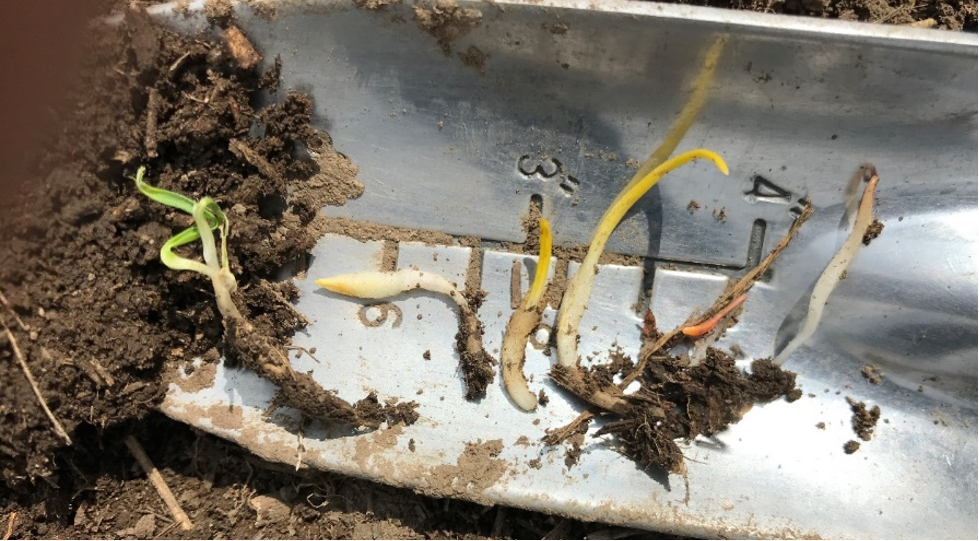
coleoptiles and stubby, stunted roots. Most susceptible weeds turn yellow
and fail to emerge.
Source: Gowan
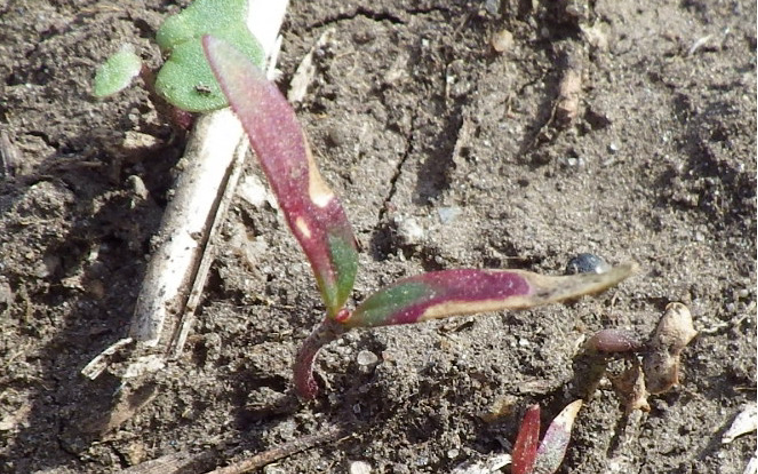
bleaching and tissue death.
Source: Jennifer Bogdan
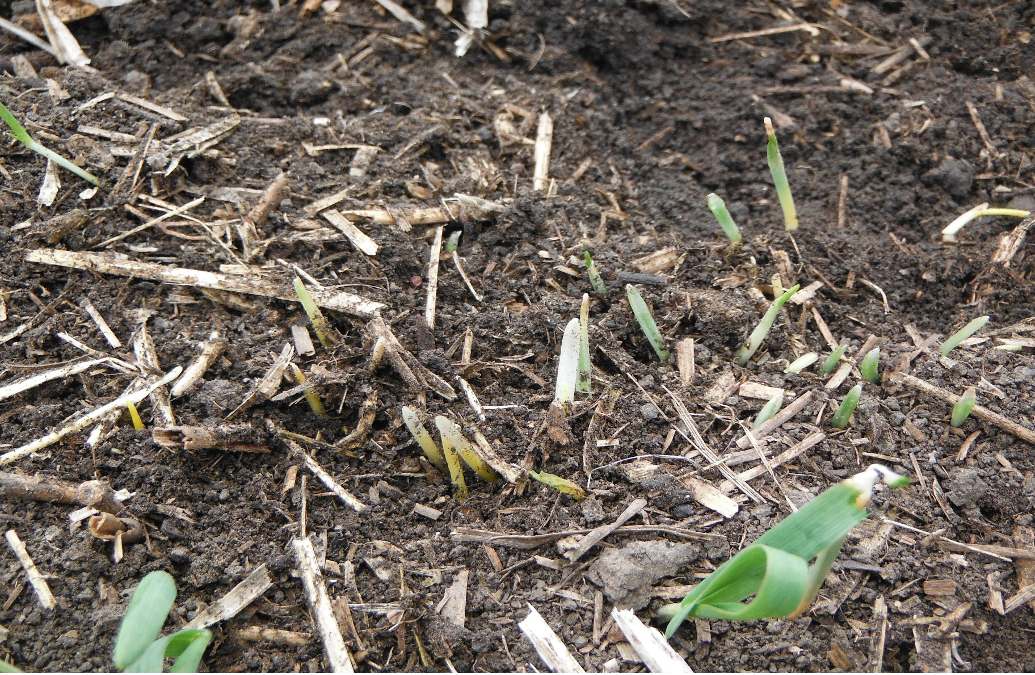
shoot growth.
Source: Gowan

coleoptile beneath the soil surface.
Source: FMC
Summary
Soil residual herbicides play an important role in pulse crops as they offer different modes of action that are critical for managing herbicide-resistant weeds. These herbicides can be applied in the fall or spring to control early germinating weeds that would otherwise emerge ahead of the crop. Because pulse crops are not very competitive with weeds, this early-season control helps to eliminate weed competition for valuable resources such as nutrients, water, light, and space. The residual component of these herbicides provide extended weed control, allowing the crop to become better established and more competitive. Soil residual herbicides are a strategic compliment to an integrated weed management plan for pulse crops.
The content presented in this fact sheet is a summary of the information available at the time of writing. Always read and follow current label directions. Further information or usage recommendations for specific herbicide products can be obtained by consulting the manufacturer representative for the products in question.
